- 4.2Impact Factor
- 7.5CiteScore
- 17 daysTime to First Decision
Machine Learning and Statistical Learning with Applications 2025
This special issue belongs to the section “AI-Driven Innovations“.
Special Issue Information
Dear Colleagues,
This Special Issue entitled “Machine Learning and Statistical Learning with Applications 2025” aims to provide a platform for showcasing cutting-edge research and innovative applications of machine learning and statistical learning methodologies. As these fields continue to evolve, their integration into diverse domains has led to breakthroughs in solving complex problems, including classification, prediction, clustering, and decision making across industries such as healthcare, finance, marketing, and engineering.
This Special Issue welcomes contributions that advance the theoretical foundations of machine learning and statistical learning or introduce novel frameworks and algorithms. We are particularly interested in works that bridge the gap between theory and practice, highlighting real-world applications and demonstrating the impact of these methods on data-driven decision making.
Topics of interest include, but are not limited to, supervised and unsupervised learning, deep learning, reinforcement learning, statistical modeling, and hybrid approaches combining machine learning and traditional statistical methods. Studies focused on addressing challenges such as data imbalance, interpretability, scalability, and ethical considerations are also encouraged.
This Special Issue invites original research articles, review papers, and case studies that present novel findings or provide comprehensive insights into existing methodologies. We aim to foster an interdisciplinary exchange of ideas, pushing the boundaries of what machine learning and statistical learning can achieve.
Dr. Yan Zhang
Guest Editor
Manuscript Submission Information
Manuscripts should be submitted online at www.mdpi.com by registering and logging in to this website. Once you are registered, click here to go to the submission form. Manuscripts can be submitted until the deadline. All submissions that pass pre-check are peer-reviewed. Accepted papers will be published continuously in the journal (as soon as accepted) and will be listed together on the special issue website. Research articles, review articles as well as short communications are invited. For planned papers, a title and short abstract (about 250 words) can be sent to the Editorial Office for assessment.
Submitted manuscripts should not have been published previously, nor be under consideration for publication elsewhere (except conference proceedings papers). All manuscripts are thoroughly refereed through a single-blind peer-review process. A guide for authors and other relevant information for submission of manuscripts is available on the Instructions for Authors page. Computers is an international peer-reviewed open access monthly journal published by MDPI.
Please visit the Instructions for Authors page before submitting a manuscript. The Article Processing Charge (APC) for publication in this open access journal is 1800 CHF (Swiss Francs). Submitted papers should be well formatted and use good English. Authors may use MDPI's English editing service prior to publication or during author revisions.
Keywords
- machine learning applications
- statistical learning
- deep learning
- supervised learning
- unsupervised learning
- reinforcement learning
- feature learning
- hybrid machine learning approaches

Benefits of Publishing in a Special Issue
- Ease of navigation: Grouping papers by topic helps scholars navigate broad scope journals more efficiently.
- Greater discoverability: Special Issues support the reach and impact of scientific research. Articles in Special Issues are more discoverable and cited more frequently.
- Expansion of research network: Special Issues facilitate connections among authors, fostering scientific collaborations.
- External promotion: Articles in Special Issues are often promoted through the journal's social media, increasing their visibility.
- e-Book format: Special Issues with more than 10 articles can be published as dedicated e-books, ensuring wide and rapid dissemination.

